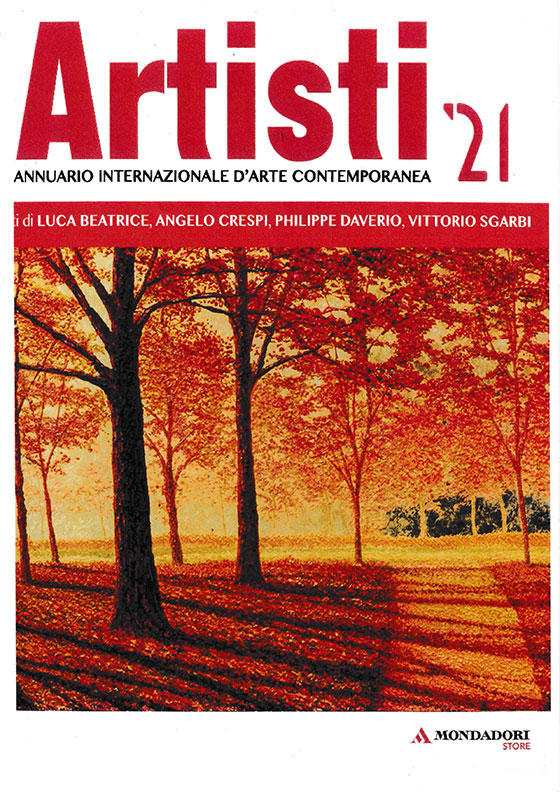
The logic of composition edited by Vittorio Sgarbi
Bongiorni favors acrylics, which heighten the explosive nature of his works. Colors and forms burst beyond the confines of the canvas, breaking free of the two-dimensional plane. The result is both fascinating and overwhelming. The consistent 100×100 format amplifies the dynamism of the composition, immediately revealing the source of the centrifugal and centripetal forces at play... more download PDF
Viewing these works is a journey that transports us from reality to a realm of pure emotion, where everything moves without purpose or utility. It’s a gift, a summons, like love and beauty. The deliberate juxtaposition of materials, colors, and forms creates a powerful and persuasive interplay of light and shadow, fostering an empathetic connection between the artwork and the viewer, essential for understanding the necessity of art. When we try to identify the logic of the composition or the reasons behind individual choices, we make a grave mistake. Each mark gains value in relation to the whole; no mark has value in itself, yet its presence is indispensable. Titles like Come ti vorrei distruggere, Voglia di libertà, Contro il muro reflect this dynamic and conflicting nature. Bongiorni depicts life in its essential form, the dialogue (dia-logos), the confrontation, the encounter between two or more opposing positions, which can culminate in conflict—the constitutive act of tragedy, the craft of living, as Pavese would say.
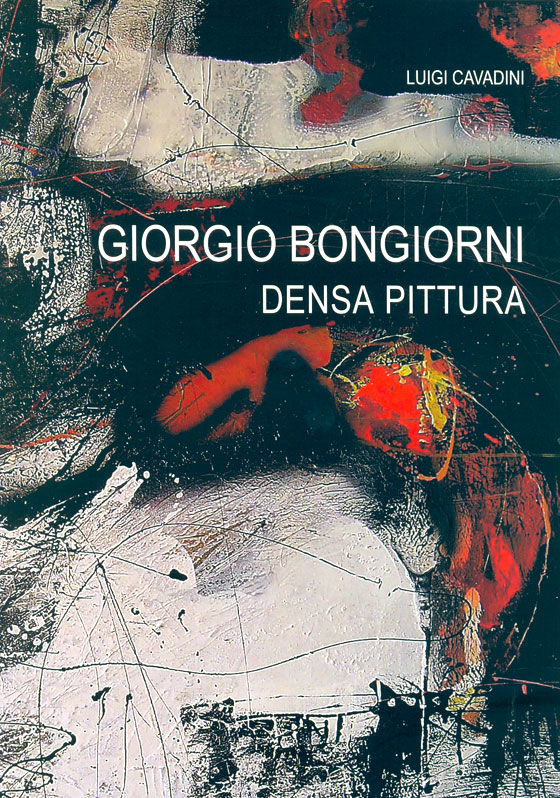
Giorgio Bongiorni. Dense brushwork by Luigi Cavadini
The painting of Giorgio Bongiorni is dense, full of expressions of the subconscious, rich in colours – from the very beginning. Going through his background, right from the start it can be seen how in time the maturation of his technique has been accompanied by a growing awareness of himself and an increasingly clearer and more concentrated pictorial expression... more download PDF
For him, painting is not a transposition of reality, neither is it a true narration of a happening or an action. Rather it is a sort of personal revelation, where he reveals and expresses his subconscious feelings. The intensity of perception and assimilation of what is outside (but not extraneous) constitutes the preconditions of what will appear on the canvas. The purification of the resulting images more or less consciously represents a fundamental moment of his research, a sort of interior filter that will be sectioned and selected. Thus when he starts this dialogue with the canvas, the solicitations that arise from inside have lost the particularity of their vision to assume the absoluteness of a message which urges to be materialized.
Here then the applying of the colours with sweeping broad brush strokes, which first of all define the atmosphere where all will take place – an atmosphere sometimes rarefied, sometimes substantial, which immediately conditions the outcome of the work. The successive phases, aspects to define and to characterise, already undergo implicit conditioning in the first touches and soon become an integral part, the tones of the final product becoming more subtle or richer. The artist’s intention does not count – here he is working on a figurative or abstract work… Perhaps he himself is not completely aware of what he is after.
Compared to traditional rules, interior tension plays a major role and so every work speaks the language of sincerity, whether panorama, a wedge of a town, pure dynamism, atmosphere of color and so on. By now the artist is absorbed by the image, which thus becomes a transposition of an interior vision and gradually constituted thanks to the sedimentation of experience and skills.
And in this image everyone can discover their own fleeting thoughts and suspended desires, places in the soul and vital spaces, figures and phantasms. Phantasms and figures. Reality that becomes abstract and abstract that takes form.
Over everything, however, dominates the strength and incisiveness of those reds, more blood reds than fire reds, the presence of which, even minimal, agitates the whole composite work. The pictorial gesture, both in the vertical /horizontal direction, calibrated and well organised, and also in that chaotic gesture that is a result of absolute creative liberty, together give lyrical value to the whole.
The spatial scansions and the fragmentations of the vision generate at times autonomous images extraneous from one other and from all possible interpretations, the value of which is determined precisely by the interactions between the autonomous parts themselves. It is here that I can detect the greatest genius of the artist who manages, in his questioning of things and space, to achieve the potential of making music with elements of limited sound.
Without doubt Giorgio Bongiorni has learnt from the experience of the great masters of the last century, taking from them valuable indications for his research. On one hand, attention has been paid to Pollock’s compositions but also Fontana, Scanavino and Baj have contributed to allow his previous work to emerge from a static immobility to give it a new creative impulse.
Along this path and with the incentive of certain painting pertaining to the informal – more eloquent here could be the reference to abstract expressionalism – have taken form (I like to use this term due to the three-dimensional value of the compositions) the corroded relief works the artist has been working on in these last years, operating both with the logic used on his previous canvases and in addition with a preparatory treatment of the “skin” of his new polystyrene material. Here thanks to the variation of light and shadow, expressive possibility is amplified in the final composition. The value of light reaches unprecedented level. If in the past this contributed to define the overall general effect of the work, emphasizing at times anger, at times melancholy, at times other sensations and sentiments, here light becomes an essential instrument to make a work of art vibrant and vital: otherwise it would have to depend solely on the contrasts of the colours, of the white and of the black.
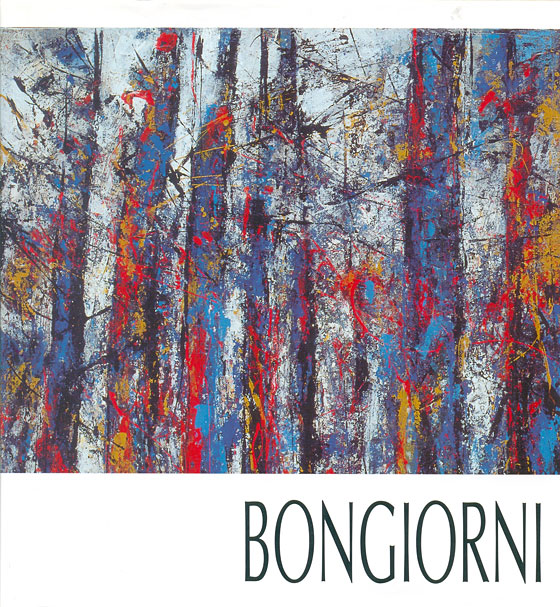
THE INTIMATE LIGHT OF THE REALITY
of Stefania Barile
A thought to see…
“ not only philosophy but also the fine arts have got the deep aim to solve the problem of existence”
Schopenhauer, Il mondo come Volontà e Rappresentazione... more download PDF
The light between reason and feeling
To live in the reality does not only mean to walk or simply to move among the things but above all to understand ,to suffer, to be happy, to enjoy all that is surrounding the daily individuality of everybody.
Even though most people let themselves get carried away by the events that ,doubtless,may become the real protagonists of the reality,only few are able to be fully aware of what is happening and fully understand the aims till they discover the roles of true producers of their own existences.
And so life, seen as natural germination from numerous and casual coincidences, gives place to the desired existence, strongly wanted,and sometimes fully conscious of the reality of facts of which it is the leading actor.
And everyone, of the few, becomes director-producer-actor of its own life, following a way that is built with diligence and determination but also chosen with own instinct, being driven by proper sensations of man,woman,human being who has got a real creative capacity of making it an ideal microcosm out of a very big,menacing and material macrocosm.
Giorgio Bongiorni is an indisputable example.
With his painting,realized with coats of paint that are consumed by the constant work of chromatic rarefaction and technical definition,he is able definitively to catch the life of things : he realizes it with few strokes of materic paint associated with a long activity of aimed removal from the canvas following a precise and studied in detail project.
Through some lightning of light the artist is able to transfer immediately the desire of discovering the reality,stripping it of his formal and official dress in order to look into the intimacy of existence.
And the light ,the dim light ,we see behind the green hills of Varese area or among the noisy waves of a known river, or behind the bared trees of the gardens in the town or on a façade of an old building with railing, all that a good observer cannot disregard ,arises from the things themselves.
This is not either a mere device to create a deeper visual depth or a dedicated reflection of a sun ray or again a chromatic demand required by the composition of the painting or a way to outline the pictorial style.
That glare, that apparently seems as instinctive as well studied with a preliminary sketch, is the light of the things themselves, able to open the reality to an uninterrupted dialogue with whom lives near, around, inside.
Moreover, the light that comes out from the things of the reality is taken as the source of ungovernable and mysterious energy, either through the rational capacity of elaborate the images once memorised and then shown as visionary flashes or above all through the passion that the life itself instigates in people who realize their own existence as something unique and unrepeatable.
A thought to create…
“ in every spirit that arrives at the point to give himself up to the contemplation purely objective of the world, has come out , even hidden and inconscious , an aspiration to catch the real essence of the things, of life and existence.”
A. Schopenhauer, Il mondo come Volontà e Rappresentazione
The light between fog and reality
In every single painting Giorgio Bongiorni tries in a proper manner to show things as they are in the reality, in that reality where they cannot be immediately sized by everybody because they are immersed in the fog by accidental,objective and subjective circumstances.
And this fog, that makes the vision soft, suffused,incomprehensible and so fleeing, disappears through the art in order to create,in a clear, limpid and open atmosphere, a purer reality.
Giorgio Bongiorni’s painting talks to his observer with a language that is simple and at the same time universal and it is shown through the colour,the technique and the style that is unique of the artist.
In front of his paintings the look is driven to the right way of imagination with images that are not completely rational but also not completely offered to the senses.
The visitor is ravished a little at a time by the colour, the dynamism of the composition,the energy that comes out through his light,so intimate to seem, sometimes, misterious.
Bongiorni’s art consists in the capacity to create the wait that reality so strongly revealed, talks to the mind and the heart of whom observes and understands it with emotion, taking away forever the melanchonic and nostalgic feeling that has arisen from his canvas for a long time.
The reality of the things has substituted the fog of the memory, giving to the light of reality all his esistential importance.
It is no longer the image that arises from the mind moved by the nostalgic whirling of a soul, anxious to find its own way but Bongiorni’s painting has reached the point where the proposed scene keeps his real features that are then continuously caught by the colour in order to be more elaborated and materialized.
Here the materic aspect is the principal element on which the artist gives his attention as the observer does, as the thick and mellow colour,that is put on the canvas with coats that are later torn with stronger or less strong movements of spatula, finally transforms itself in pictorial material to see, touch and taste.
Only the light remains misteriously in a rarefied condition.
The released energy is directed to the pure vision of the things to be shown.
It seems rarefied,impalpable,intimate.
A thought to discover…
“ in front of a painting we need to have the same attitude we will have in front of a prince : to wait without knowing whether we will be told or what we will be told.”
A. Schopenhauer, Il mondo come Volontà e Rappresentazione
The intimate light of the reality
To dialogue with a reality that has become , thanks to a magic spell of a creative soul that has revealed its bright intimacy, painting.
To let us drive among the coats of paint till the root of the vision ,within a precise contour, sometimes outlined by the chromatic power of the scarlet red.
To feel the rash sensation of disclosure that we realize only when we have got the awareness to have found the origin, the cause,the source of the real things.
To smell the scent of intimacy of a life,that now unarmed,trusts first the artist’s alert look and then the observer’s one.
Giorgio Bongiorni’ s painting, in his reached expressive maturity, is able to transmit the glamour of the discovery of the “daily”.
His painting consists of a deep passion for a reality that is either foregone or deeply ignored, however intimately present in the artist’s life.
It is the desire to live the atmosphere that everyday surrounds the things that guides the artist toward a continuous,tireless and eternal research.
Giorgio Bongiorni seeks to find and finds to seek again the light, that hidden inside and behind the things,gives the possibility to believe life and to solve, even only a fleeting image, temporary and exemplifying, as the figurative arts, differently from philosophy can do, the awkward matter of existence.

Melancholy, powerful and visionary
Fabrizia Buzio Negri
The “Melancolia” of Durer; pensive, big half-outspread wings. The moment of suspension. The sudden intuition which occurs when everything around seems to be otherwise. Far of the sun, whilst the darkness draws in.
Giorgio Bongiorni has chosen to look at the world from this position of privilege, foreign to a lot of unforeseeable aesthetic and conceptual theories,.. more download PDF
according to which artists become interesting when they follow itineraries of contempory or openly hypertechnological or, on the contrary, “trash”.
For Bongiorni painting must be interpreted as a highly imaginative bridge suspended between poetry and literature, a refuge in the levity of silences in the vastness of emotions, in flow of the life slipping by. The split second is the unity of measure, unlike the “realistic” impression: it leads us inside a universe made up of fragments, memories, apparitions, a synonym of transience, where time of actions doesn’t exist, but is transformed into time of imagination. Powers of rationality no longer exist: on expanding temporality lights up, in which everything assumes the refraction of an echo.
Shades evoked which pass only once and which the artist fixes forever on a canvas: “Un dì si venne a me Malinconia / e disse: “Io voglio un poco stare teco”; / e parve a me ch’ella menasse seco / Dolore e Ira per la sua compagnia.” Words written by Dante Alighieri in a famous sonnet.
In the darknight hours, in the brightness of the day. The “Melancolia” flows as a quiver, suddenly in the unrepeatable condition of life. There is no falling back on sadness: it is a charm suspended between certainty and uncertainty, in a feeling of change and metamorphosis of visible things. So arrives that “magic” time which inspires poets, which fascinates painters, intense and exceptionally short moments. Nature’ s breath, the sight of a landscape, the things around: everything is translated into Bongiorni’s paintings within the infinite use of colour and matter.
In the last decade the artist has reached and still lives in a short of condition of grace: wise distribution of chromatic spaces, the thin grain of the matterin the use of transparence. Figurative revelation -at the same time both sweet and resonant- are found again in the itinerary of memory. Melancholy, from which the mystery of the flight of fancy originates, is the enigma of vision and it enables that procedure of reapperances to become visible at the very moment that the mind and the heart are taken towards a deep and unknowndimension of being. The safety area of rationality is over; the dizziness of imaginary dimension springing from reality takes over. Time and space are attenuated inside the work.
Bongiorni’s pictorical tales are not at all reassuring they instill ghosts of an unpredictable memory.
A subtle restlessness is perceived as if everything is bound to fall into an abyss after a split second. Melancholy, ancient ambivalence. Magic moment and disturbing uncertainty. Peace of spirit, which the instability of the present tries to reach. In the mined territory of memory and imponderable things, history is moving quickly towards the present day and is trying to overcome fear.And so Melancholy becomes an instrument in the field of vision.
Giorgio Bongiorni’s paintings are an open interrogation of the images that take place inside an emotion, in an aesthetic choice between reality and unreality, an intermediate point, extremely mobile, to reveal the invisible in the visible world.
That beginning in ‘91 in “Natura morta con case”, from the foreground subjectively individualized, leads to the ambiguosly figurative aspects of constructions in the background, in animaginative concentration which a hidden force poetically puts together. The way of composing the figurative synthesis, in the work as in other works is absolutely free, in a vision of realities put on where neither spatial or temporal order exists but every element is subjected to the trend of suggestion. A contamination of types exists: the still life takes its place in “plein air” adding itself over the view. The distance brought closer on a lirically evocative backdrop recalls a surreality projected inside. The mystery of things reveals the presence of “divine” Melancholy.
The volume stand out from the combination of colours which suggest tridimensionality: the perspective feelings ideally lead farther on to other intuitable and extensible dimensions. At first visual impact the real subject of the picture is just the colour supported by the way of painting of the work which thickens or crumbles up a mixed technique capable of large motions of surface.
It is the case of “Lo studio dell’artista”, (1993), dazzled by a feeble light that clearly overwhelms and puts a part of canvas into the shade. It is an ascent of variations assaulted in a sequence of reddish chromatism and dark marks in the identification of real elements.
Rare are the human figures present in Bongiorni’ s compositions; they are almost always shades which emerge from chromatic saturations, not expected, in a free association of thought and poetry, as in his recent work “Nella luce del sole” of 1998.
Otherwise the picturesque theme is self-sufficient, since the existential motivations take place as “present in their absence”, in the changing of the atmosphere tones which produce a free passing of subjective and objective accent.
When evening falls, the “Luce del tramonto nel vicolo” throws any balance formerly reached into confusion and makes the illusive search for a reality even more difficult to cling to. It is Melancholy. It is the poetic spleen.
The artist turns to an insubstantiality of mimetic connotations. We find ourselves in front of spaces split up in colour, where gesture often takes first place as in “Malinconia di settembre”,which goes from vegetable shapes in the foreground to become abstract in a trend of strong chromatic repercussions with dull orange tones and black vibrations supreme.
Yet again, “Lo studio di Via Ristori”, 1994, appears behind a thin working of matter, where time and place irremediably lose their representationism in the colour filtered through a fragment of a tree which verticalizes the composition.
For “Sintesi di paesaggio No. 1”, once again it is the great play of chromatism which nurtures our fantasy, along which runs the visionary tension of references to real life which become absorbed into the matter thickness and into the different weights of colours from hot blades of light to the obsessive resounding presence of black..
Once again into tones of black sinks the “Luce del tramonto”, 1996, where the whitewash of the wall acquires the metamorphosis of reddish hues until they vanish on an intensely evoked window and balcony. These luminous laps swallow ambiguous urgencies which become visionaries, dragging us into a dark zone.
And the aggression of “Notturno rosso” agitates the pictorial surface, a place of real life experiences in an exaltation of pure colour.
It is the same flood of colour, in the mobility of the matter, which organizes the spaces in “Parete rossa”, 1997, in forms redeveloped through disquieting stratification, deep sensations, mysterious forces which upset the scene, a loss of the imagination rather than places of every day reality.
In “Presagio”, a work of the same year, the imaginary possibilities of the scene fluctuate the informality of arrangements of the matter and colour, between exterior and interior oscillations where each composite element is absorbed in another.
The genre “Natura morta”reappears periodically, each time overflowing with tenderness and anguish in that fragmentation of light and colour the matter is immersed in.From “Natura morta”, 1995, to “Natura morta con interno”, 1996, to the present day “Natura morta con paesaggio”, up to “Composizione”, 1997, multiple suggestion abound. They are pages of natural poetry which the progressive figurative breakup never puts in doubt. The referent element of the support table places itself in a continuous dialectic variation with what surrounds it, in that light, sometimes different, sometimes more deeply inspired to the urgency of a sudden inner echo. The interlocking pieces come into the mind in a flash and challenge the dizziness of an interior-exterior betwitched as by ghosts.
In the more recent paintings, the suggestion of a place within space is not even hinted at but grasped intuitively in the anxious immediacy of deciphering. The dense stratifications of matter themselves in different graduations of coloured pigments reveal a becoming, “luogo naturale luogo della mente”, in emotional and sensitive anguish, unforeseeable in the unexpected illumination as a tormented involvement of brownish tones.
The canvas becomes an open background for the suspense of “Melencolia”, a powerful and obscure feeling, in the heat produced by violent visual sensations.
Intuition of a scene perceived horizontally takes the viewer towards a territory full of humours, contamination of reality and primordiality, a reflection of an enthralling feeling, where the secret energy springing from “Grande spaccatura di luce”, 1998, appropriates itself of all reference to the threshold of obscurity, weaving in the shade an infinite story, full of dreams and drama, towards something unfathomable. Like the soul.
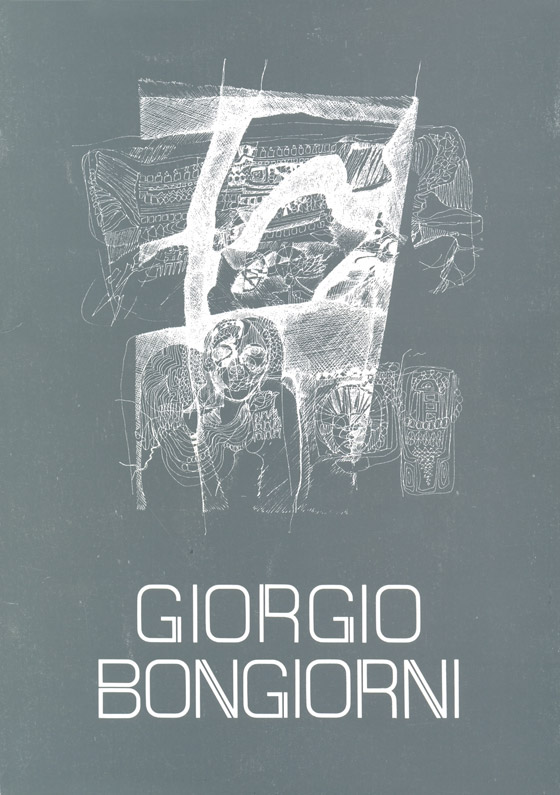
Critical report by Professor Silvio Zanella, Director of the Modern Art Museum of Gallarate
I have been following Giorgio Bongiorni’s artistic activity since the 1970s. In 1979, I presented an exhibition of his paintings that were, and still are, a powerful expression of spiritual liberation. They are the confession of an artist who refuses to submit to the dehumanizing effects of technology... more download PDF
The titles of these works, such as “Capitulation of an Ideal,” “Separation of Evil,” and “Rebellion Against Conditioning,” speak for themselves. Their intense colors and jagged forms reflect a world where the boundaries between machine and human are blurred.
After a few years, Bongiorni’s style evolved. His palette softened, and his forms became more fluid and expressive. The anger and rebellion of his earlier work gave way to dreams and melancholy.
As the machine receded from his canvases, the human figure and its environment took center stage. Landscapes, architecture, and decorative motifs became integral to his compositions. These elements, drawn from memory and imagination, formed the basis of his fantastical and surreal narratives.
Throughout the 1980s, Bongiorni continued to explore new possibilities. His technique became increasingly refined, blending broad brushstrokes with intricate details. His paintings became luminous, drawing light from within rather than relying on external sources.
Bongiorni’s work is characterized by its exploration of the fantastical and its rejection of conventional reality. His visionary figures, often fragmented and distorted, reflect a sense of unease and disorientation. Yet, there is also a profound beauty and spirituality in his work.
His recent paintings, from the early 1990s, present mysterious forms inspired by dreams and anxieties. These works are imbued with a sense of sweetness and natural grace, a testament to the artist’s deep understanding of the human soul.
Silvio Zanella
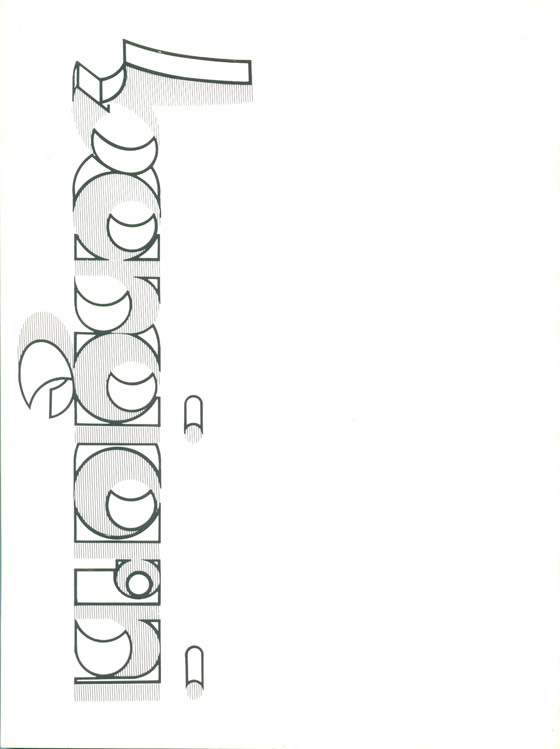
Critical Review by Professor Silvio Zanella, Director of the Modern Art Museum of Gallarate
Anyone who has seen Giorgio Bongiorni’s unreal, blue-hued landscapes from the 1970s and now approaches the recent paintings on display in this Gallarate exhibition is justified in starting. In these new visionary images, they will find unexpected positions of form and content... more download PDF
Bongiorni’s current works focus on the dynamic transformation of man into a complex and dissolving mechanical construction. The immediate impression is one of metamorphosis: man transformed into a robot, an apocalyptic warrior. It is a harrowing materialization of the cruel aggression that erupts on our planet every day. A materialization of the loss of humanity, joy, and love: as the external forms change, so too do the conditions of the spirit, revealing a state of decay.
Rigid, metallic geometric forms; volumes that twist, multiply, and disperse in dense, heavy atmospheres, reflected in incendiary reds and bloody, smoky greens of poisonous gases. These visions arise from an anguished and terrified subconscious that rebels and denounces: an expression of liberating exorcism.
These works demonstrate the painter’s maturity, his love for plastic form, for pictorial matter, and for his craft.
Silvio Zanella
Broad brushstrokes alternate with dense clusters of vibrant color, characterized by a constant control and balance of tonal timbre. His meticulous execution avoids improvisation and chance. His paintings become increasingly luminous, emitting a non-descriptive light that emanates from within the artwork itself, a product of its intrinsic qualities. His visionary figurations are shattered and fragmented into multiple parts by abstracting layers of space, accentuating the viewer’s sense of unease and discomfort. download PDF
Deborah Ferrari
Bongiorni weaves his canvases like a goddess, and sometimes like Arachne, constantly challenging himself. The warp and weft of memory-matter provide the very depth that, from the surface of the visual, induces the viewer to go beyond, to enter; sometimes throwing you in, sometimes guiding you by the hand. Bongiorni’s work – from the minute and precious graphics like jewels to the large canvases that shout architectural space – is a concert of memory-blood/ sensation-word/ story-fairy tale/ work-poetry/ love-despair, in which fantastic inspiration, visual reality, and technical skill are harmonized in an attempt to reproduce the primordial “La”. download PDF